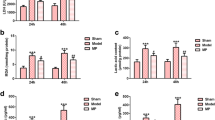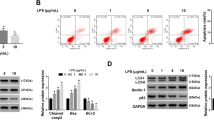Abstract
Spinal cord injury (SCI) is known as a central nervous system disorder. Previous studies suggested that long-non-coding RNA RMRP (LncRNA RMRP) was abnormally expressed in SCI, but the potential underlying mechanism remains to be further explored. To explore the regulatory roles of LncRNA RMRP/miR-766-5p/FAM83A axis in SCI. Spinal T9 hemisection was performed on healthy adult male Sprague Dawley (SD) rats to establish the SCI rat models. The expressions of LncRNA RMRP in spinal cord of rats in different groups were examined by RT-qPCR. Moreover, AGE1.HN and PC12 cells were treated with hypoxic condition, and expression of LncRNA RMRP was examined by RT-qPCR methods. Furthermore, hypoxic PC12 cells were transfected with LncRNA RMRP OE, and the cell viability, proliferation, and apoptosis were examined. Next, the direct targeting relationship between LncRNA RMRP and miR-766-5p, as well as miR-766-5p and FAM83A, was confirmed by dual-luciferase reporter and RNA pull-down assays. Finally, the effects of LncRNA RMRP/miR-766-5p/FAM83A axis on cell viability, proliferation, and apoptosis were examined. LncRNA RMRP was downregulated in SCI rats and over-expression of LncRNA RMRP alleviated the SCI condition. LncRNA RMRP over-expression increased the viability and proliferation, and inhibited the apoptosis of hypoxic PC12 cells in vitro. miR-766-5p was confirmed as a target of LncRNA RMRP, and FAM83A was confirmed as a target of miR-766-5p. LncRNA RMRP could regulate the proliferation and apoptosis of hypoxic PC12 cells via regulating miR-766-5p/FAM83A axis in vitro. LncRNA RMRP may contribute to the pathogenesis of SCI via regulating miR-766-5p/FAM83A axis.







Similar content being viewed by others
Data Availability
The datasets generated during and/or analyzed during the current study are available from the corresponding author on reasonable request.
References
Heroux ME, McCaughey E, Gandevia SC (2022) Poor statistical reporting in a spinal cord injury clinical trial. Brain 145:e1–e2
Gao T, Huang F, Wang W, Xie Y, Wang B (2022) Interleukin-10 genetically modified clinical-grade mesenchymal stromal cells markedly reinforced functional recovery after spinal cord injury via directing alternative activation of macrophages. Cell Mol Biol Lett 27:27
Habibi Arejan R, Asgardoon MH, Shabany M et al (2022) Evaluating prehospital care of patients with potential traumatic spinal cord injury: scoping review. Eur Spine J 31:1309–1329
Sinnott B, Ray C, Weaver F et al. (2022) Risk factors and consequences of lower extremity fracture nonunions in veterans with spinal cord injury. JBMR Plus 6:e10595
Noble BT, Brennan FH, Wang Y et al (2022) Thoracic VGlut2(+) spinal interneurons regulate structural and functional plasticity of sympathetic networks after high-level spinal cord injury. J Neurosci 42:3659–3675
Li M, Yang X, Sun N et al (2022) Dietary restriction may attenuate the expression of cell death-related proteins in rats with acute spinal cord injury. World Neurosurg 162:e475–e483
Alexander KA, Tseng HW, Kulina I et al (2022) Lymphocytes are not required for neurogenic heterotopic ossification development after spinal cord injury. Neurotrauma Rep 3:87–96
Hoevenaars D, Holla JFM, Postma K, van der Woude LHV, Janssen TWJ, de Groot S (2022) Associations between meeting exercise guidelines, physical fitness, and health in people with spinal cord injury. Disabil Rehabil 1–8
Yang Z, Li X, Luo W, Wu Y, Tang T, Wang Y (2022) The involvement of long non-coding RNA and messenger RNA based molecular networks and pathways in the subacute phase of traumatic brain injury in adult mice. Front Neuroinform 16:794342
Cai Z, Li S, Yu T, Deng J, Li X, Jin J (2022) Non-coding RNA regulatory network in ischemic stroke. Front Neurol 13:820858
Zhang J, Hao X, Chi R et al (2022) Whole transcriptome mapping identifies an immune- and metabolism-related non-coding RNA landscape remodeled by mechanical stress in IL-1beta-induced rat OA-like chondrocytes. Front Genet 13:821508
Xuan L, Fu D, Zhen D, Bai D, Yu L, Gong G (2022) Long non-coding RNA Sox2OT promotes coronary microembolization-induced myocardial injury by mediating pyroptosis. ESC Heart Fail 9:1689–1702
Li H, Tian G, Tian F, Shao L (2022) Long non-coding RNA TUG1 promotes osteosarcoma cell proliferation and invasion through inhibition of microRNA-212-3p expression. Exp Ther Med 23:280
Song Z, Xing F, Jiang H, He Y, Lv J (2022) Long non-coding RNA TP73-AS1 predicts poor prognosis and regulates cell proliferation and migration in cervical cancer. Arch Med Sci 18:523–534
Zhu H, Xu H, Ma H et al (2020) LncRNA CASC2 inhibits astrocytic activation and adenosine metabolism by regulating PTEN in pentylenetetrazol-induced epilepsy model. J Chem Neuroanat 105:101749
Wang J, Hu B, Cao F, Sun S, Zhang Y, Zhu Q (2015) Down regulation of lncSCIR1 after spinal cord contusion injury in rat. Brain Res 1624:314–320
Yu Y, Cao F, Ran Q, Wang F (2017) Long non-coding RNA Gm4419 promotes trauma-induced astrocyte apoptosis by targeting tumor necrosis factor alpha. Biochem Biophys Res Commun 491:478–485
Caglar YS, Demirel A, Dogan I et al (2018) Effect of riluzole on spinal cord regeneration with hemisection method before injury. World Neurosurg 114:e247–e253
He X, Zhang J, Guo Y, Yang X, Huang Y, Hao D (2022) Exosomal miR-9-5p derived from BMSCs alleviates apoptosis, inflammation and endoplasmic reticulum stress in spinal cord injury by regulating the HDAC5/FGF2 axis. Mol Immunol 145:97–108
Wang H, Yao G, Li L, Ma Z, Chen J, Chen W (2020) LncRNA-UCA1 inhibits the astrocyte activation in the temporal lobe epilepsy via regulating the JAK/STAT signaling pathway. J Cell Biochem 121:4261–4270
Palazzo C, Buccoliero C, Mola MG et al (2019) AQP4ex is crucial for the anchoring of AQP4 at the astrocyte end-feet and for neuromyelitis optica antibody binding. Acta Neuropathol Commun 7:51
Yi J, Chen B, Yao X, Lei Y, Ou F, Huang F (2019) Upregulation of the lncRNA MEG3 improves cognitive impairment, alleviates neuronal damage, and inhibits activation of astrocytes in hippocampus tissues in Alzheimer’s disease through inactivating the PI3K/Akt signaling pathway. J Cell Biochem 120:18053–18065
Jiang ZS, Zhang JR (2018) LncRNA SNHG5 enhances astrocytes and microglia viability via upregulating KLF4 in spinal cord injury. Int J Biol Macromol 120:66–72
Nguyen LH, Ong W, Wang K, Wang M, Nizetic D, Chew SY (2020) Effects of miR-219/miR-338 on microglia and astrocyte behaviors and astrocyte-oligodendrocyte precursor cell interactions. Neural Regen Res 15:739–747
Qian Z, Chang J, Jiang F et al (2020) Excess administration of miR-340-5p ameliorates spinal cord injury-induced neuroinflammation and apoptosis by modulating the P38-MAPK signaling pathway. Brain Behav Immun 87:531–542
Pinchi E, Frati A, Cipolloni L et al (2018) Clinical-pathological study on beta-APP, IL-1beta, GFAP, NFL, Spectrin II, 8OHdG, TUNEL, miR-21, miR-16, miR-92 expressions to verify DAI-diagnosis, grade and prognosis. Sci Rep 8:2387
Liu R, Wang W, Wang S, Xie W, Li H, Ning B (2018) microRNA-21 regulates astrocytic reaction post-acute phase of spinal cord injury through modulating TGF-beta signaling. Aging (Albany NY) 10:1474–1488
Fan H, Zhang K, Shan L et al (2016) Reactive astrocytes undergo M1 microglia/macrohpages-induced necroptosis in spinal cord injury. Mol Neurodegener 11:14
Wang Y, Sun JC, Wang HB et al (2018) Effects of microRNA-494 on astrocyte proliferation and synaptic remodeling in the spinal cord of a rat model of chronic compressive spinal cord injury by regulating the NoGo/Ngr signaling pathway. Cell Physiol Biochem 48:919–933
Wang CY, Yang SH, Tzeng SF (2015) MicroRNA-145 as one negative regulator of astrogliosis. Glia 63:194–205
Zhang K, Wu S, Li Z, Zhou J (2017) MicroRNA-211/BDNF axis regulates LPS-induced proliferation of normal human astrocyte through PI3K/AKT pathway. Biosci Rep 37:BSR20170755
Tu Z, Li Y, Dai Y et al (2017) MiR-140/BDNF axis regulates normal human astrocyte proliferation and LPS-induced IL-6 and TNF-alpha secretion. Biomed Pharmacother 91:899–905
Luan Y, Chen M, Zhou L (2017) MiR-17 targets PTEN and facilitates glial scar formation after spinal cord injuries via the PI3K/Akt/mTOR pathway. Brain Res Bull 128:68–75
Hong P, Jiang M, Li H (2014) Functional requirement of dicer1 and miR-17-5p in reactive astrocyte proliferation after spinal cord injury in the mouse. Glia 62:2044–2060
Zhou F, Wang X, Liu F, Meng Q, Yu Y (2020) FAM83A drives PD-L1 expression via ERK signaling and FAM83A/PD-L1 co-expression correlates with poor prognosis in lung adenocarcinoma. Int J Clin Oncol 25:1612–1623
Yu J, Hou M, Pei T (2020) FAM83A is a prognosis signature and potential oncogene of lung adenocarcinoma. DNA Cell Biol 39:890–899
Yu WS, Wang ZG, Guo RP, Lin ZQ, Ye ZW, Lu CL (2020) Hepatocellular carcinoma progression is protected by miRNA-34c-5p by regulating FAM83A. Eur Rev Med Pharmacol Sci 24:6046–6054
Liu C, Peng X, Li Y et al (2020) Positive feedback loop of FAM83A/PI3K/AKT/c-Jun induces migration, invasion and metastasis in hepatocellular carcinoma. Biomed Pharmacother 123:109780
Marino N, German R, Podicheti R et al (2022) FAM83A is a potential biomarker for breast cancer initiation. Biomark Res 10:8
Lee SY, Meier R, Furuta S et al (2012) FAM83A confers EGFR-TKI resistance in breast cancer cells and in mice. J Clin Invest 122:3211–3220
Huang H, Yang C, Zhang Q et al (2022) Long non-coding RNA FAM83A antisense RNA 1 (lncRNA FAM83A-AS1) targets microRNA-141-3p to regulate lung adenocarcinoma cell proliferation, migration, invasion, and epithelial-mesenchymal transition progression. Bioengineered 13:4964–4977
Chen Z, Hu Z, Sui Q et al (2022) LncRNA FAM83A-AS1 facilitates tumor proliferation and the migration via the HIF-1alpha/ glycolysis axis in lung adenocarcinoma. Int J Biol Sci 18:522–535
Zhao J, Zhao F, Yang T et al (2022) FAM83A has a pro-tumor function in ovarian cancer by affecting the Akt/Wnt/beta-catenin pathway. Environ Toxicol 37:695–707
Ning Z, Tian Y, Li Y et al (2022) Exosomal circ_0007385 enhances non-small cell lung cancer cell proliferation and stemness via regulating miR-1253/FAM83A axis. Anticancer Drugs 33:61–74
Liu Z, Zhang Y, Dang Q et al (2021) Genomic alteration characterization in colorectal cancer identifies a prognostic and metastasis biomarker: FAM83A|IDO1. Front Oncol 11:632430
Funding
This work was supported by the Science and Technology Project of Nantong City (Grant Number: JC2020013) and Postgraduate Research & Practice Innovation Program of Jiangsu Province (Grant Number: KYCX21_3107), Medical Research Project of Jiangsu Commission of Health (Grant Number: ZDB2020004), and Nantong Health Commission Research Project (Grant Number: MA2021016).
Author information
Authors and Affiliations
Contributions
All authors contributed to the study conception and design. Material preparation, data collection, and analysis were performed by HXH and GHX. The first draft of the manuscript was written by HXH and GHX, and all authors commented on previous versions of the manuscript. All authors read and approved the final manuscript.
Corresponding author
Ethics declarations
Ethics Approval
The current study has been approved by the animal ethical committee of Nantong University.
Consent to Participate
Not applicable.
Consent for Publication
Not applicable.
Conflict of Interest
The authors declare no competing interests.
Research Involving Human Participants and/or Animals
The current study has been approved by the animal ethical committee of Nantong University.
Informed Consent
Not applicable.
Additional information
Publisher's Note
Springer Nature remains neutral with regard to jurisdictional claims in published maps and institutional affiliations.
Rights and permissions
Springer Nature or its licensor holds exclusive rights to this article under a publishing agreement with the author(s) or other rightsholder(s); author self-archiving of the accepted manuscript version of this article is solely governed by the terms of such publishing agreement and applicable law.
About this article
Cite this article
Hong, H., Xu, G., Chen, J. et al. LncRNA RMRP Contributes to the Development and Progression of Spinal Cord Injury by Regulating miR-766-5p/FAM83A Axis. Mol Neurobiol 59, 6200–6210 (2022). https://doi.org/10.1007/s12035-022-02968-3
Received:
Accepted:
Published:
Issue Date:
DOI: https://doi.org/10.1007/s12035-022-02968-3




